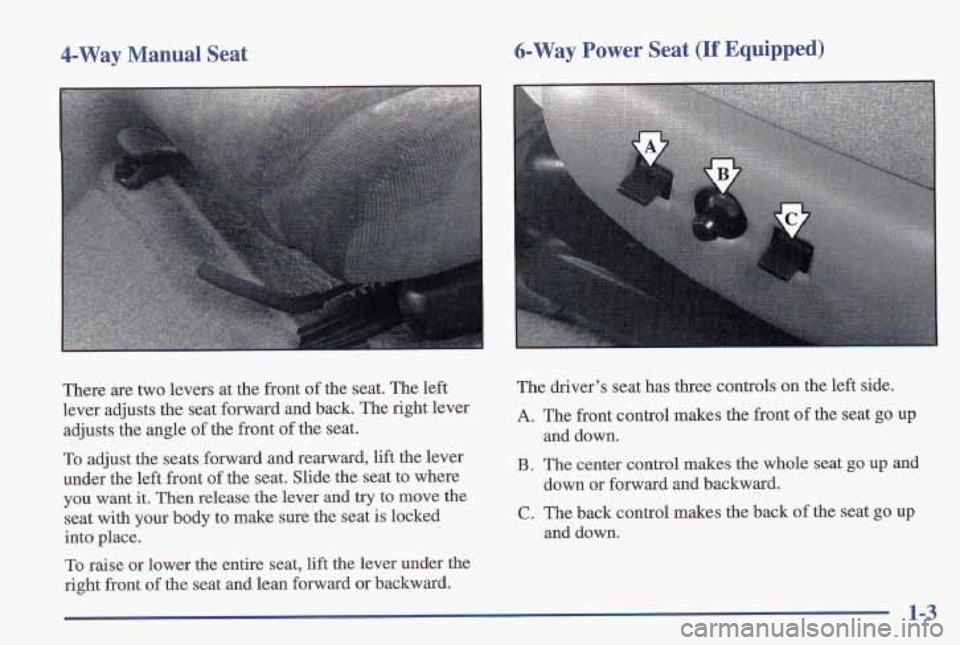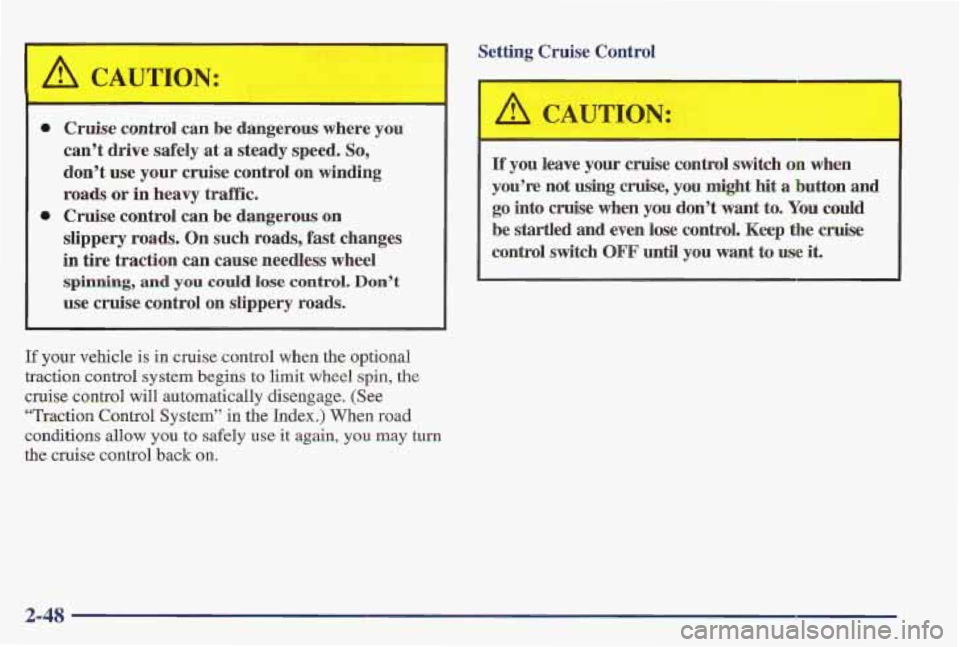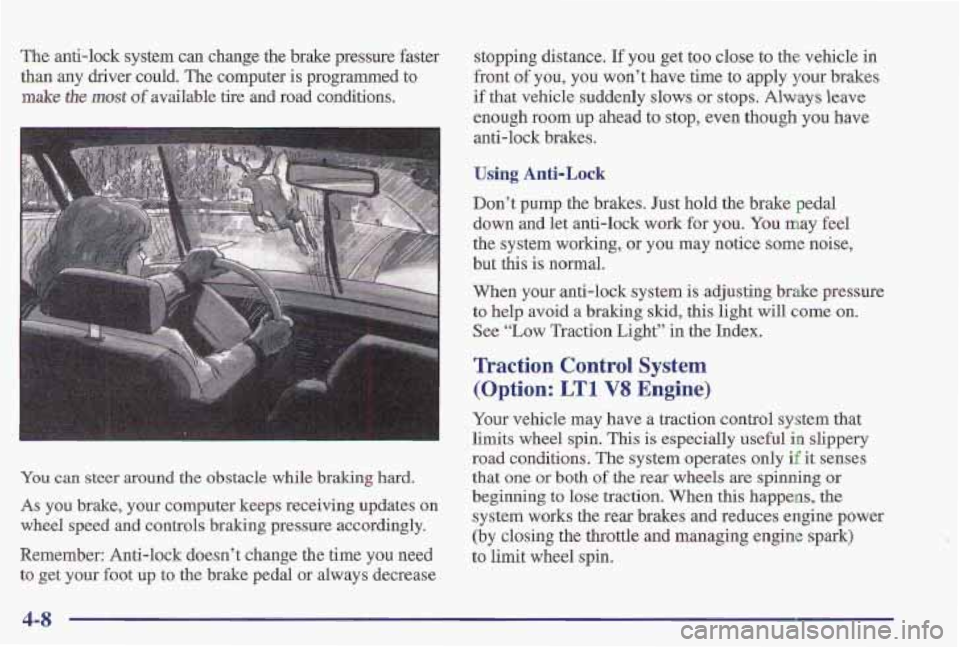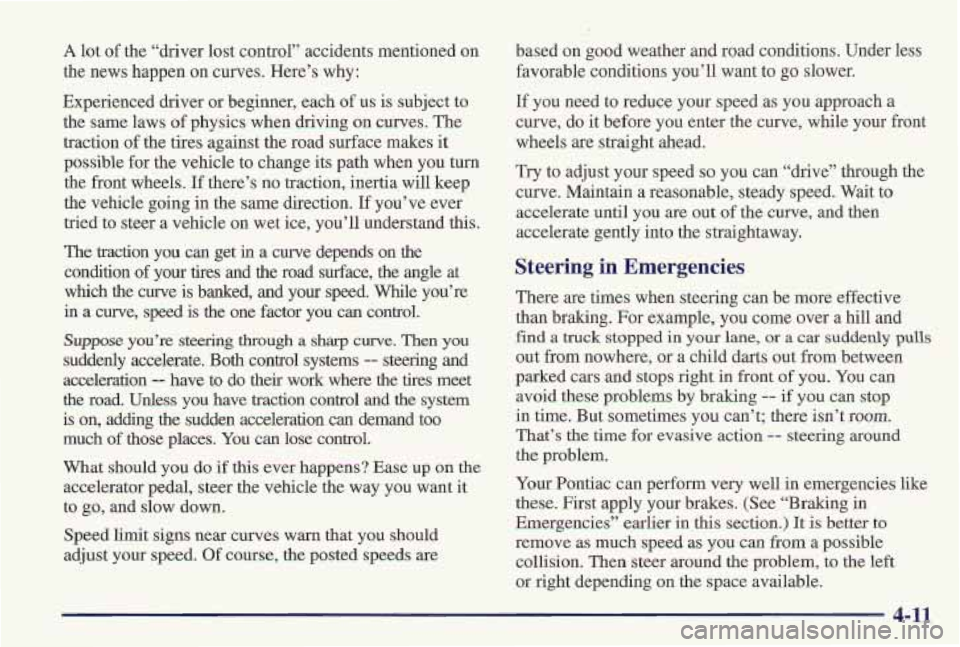Tire PONTIAC FIREBIRD 1997 Owners Manual
[x] Cancel search | Manufacturer: PONTIAC, Model Year: 1997, Model line: FIREBIRD, Model: PONTIAC FIREBIRD 1997Pages: 410, PDF Size: 19.2 MB
Page 2 of 410

The 1997 Pontiac Firebird Owner’s Manual
1-1
2-1
3-1
4-1
5-1
6-1
7-1
8-1
Seats and Restraint Systems
This section tells you how to use your seats and safety belts\
properly. It also explains the “SRS” system.
Features and Controls
This section explains how to start and operate your Pontiac.
Comfort Controls and Audio Systems
This section tells you how to adjust the ventilation and comfo\
rt controls and how to operate your audio system.
Your Driving and the Road
Here you’ll find helpful information and tips about the road\
and how to drive under different conditions.
Problems on the Road
This section tells what to do if you have a problem while driving, such as a flat tire or overheated engine, etc.
Service and Appearance Care
Here the manual tells you how to keep your Pontiac running properly and\
looking good.
Maintenance Schedule
This section tells you when to perform vehicle maintenance and \
what fluids and lubricants to use.
Customer Assistance Information
This section tells you how to contact Pontiac for assistance a\
nd how to get service and owner publications.
It also gives you information
on “Reporting Safety Defects” on page 8-10.
9-1 Index
Here’s an alphabetical listing of almost every subject in this manual. You can use it to quickly find
something
you want to read.
Page 10 of 410

4-Way Manual Seat 6-Way Power Seat (If Equipped)
There are two levers at the front of the seat. The left
lever adjusts the seat forward and back. The right lever
adjusts the angle of the front
of the seat.
To adjust the seats forward and rearward, lift the lever
under
the left front of the seat. Slide the seat to where
you want it. Then release the lever and try to move the
seat with your body to
make sure the seat is locked
into place.
To raise or lower the entire seat, lift the lever under the
right front
of the seat and lean forward or backward. The
driver’s seat has three controls on the left
side.
A. The front control makes the front of the seat go UP
and down.
B. The center control makes the whole seat go up and
down or forward and backward.
C. The back control makes the back of the seat go up
and down.
1-3
Page 62 of 410

If your vehicle has this option, it has a theft-deterrent
alarm system. Once armed, the system will sound the
horn and flash the parking lamps if the vehicle is
broken into.
Shock Sensor
Coupe Convertible
The shock sensor is what triggers the alarm when it
detects a blow to your vehicle. It
is located over the
right rear wheelhouse near the spare
tire in the hatch
area. There are two levels of alarms via the shock
sensor: Two horn blasts and parking lamp flashes for
non-threatening blows to the vehicle and
a full two
minute alarm for harder blows to the vehicle. Its
sensitivity can be adjusted if more or less sensitivity is
desired. (Note: If sensitivity is increased too much,
it
may give false alarms caused by gusts of wind or other
natural events that may shake the vehicle).
To adjust, remove the label covering the adjustment
knob on the sensor and adjust as desired. Turn clockwise
to increase sensitivity and turn counterclockwise to decrease sensitivity. The shock sensor
is ignored by the
alarm system when the ignition is on, when the hatch is
open, when the alarm is disarmed, when it is customized
to be ignored and for five seconds after
the horn sounds
an alarm or chirp. The shock sensor is ignored after
triggering three full alarms until the system is rearmed.
2-13
Page 97 of 410

Cruise control can be dangerous where you
can’t drive safely at
a steady speed. So,
don’t use your cruise control on winding
roads or in heavy traffic.
slippery roads. On such roads, fast changes
in tire traction can cause needless wheel
spinning, and you cauld lose control. Don’t
use cruise control on slippery roads.
0 Cruise control ‘can be dangerous on
If your vehicle is in cruise control when the optional
traction control system begins to limit wheel spin,
the
cruise control will automatically disengage. (See
“Traction Control System” in the Index.) When road
conditions allow you to safely use it again, you may turn
the cruise control
back on.
Setting Cruise Control
~ ~~~
If you leave your cruise control switch on when
you’re not using cruise, you might
hit a button and
go into cruise when you don’t want to. You could
be startled and even lose control. Keep the cruise
control switch OFF until you want to use it.
2-48
Page 170 of 410

Drinking and then driving is very dangerous.
Your reflexes, perceptions, attentiveness and
judgment can be affected by even
a small amount
of alcohol. You can have a serious -- or even
fatal
-- collision if you drive after drinking.
Please don’t drink and drive or ride with
a driver
who has been drinking. Ride home in
a cab; or if
you’re with
a group, designate a driver who will
not drink.
Control of a Vehicle
You have three systems that make your vehicle go where
you want it to
go. They are the brakes, the steering and
the accelerator. All three systems have
to do their work
at the places where the tires meet the road. Sometimes,
as when you’re driving
on snow or ice, it’s
easy to ask more
of those control systems than the tires
and road can provide. That means
you can lose control
of your vehicle.
Page 171 of 410

Braking
Brakmg action involves perception time and
reaction time.
First, you have to decide to push on the brake pedal,
That’s
perception time. Then you have to bring up your
foot and
do it. That’s reaction time.
Average reaction time is about 314 of a second. But
that’s only an average. It might be less with one driver
and as long as two or three seconds
or more with
another. Age, physical condition, alertness, coordination
and eyesight all play a part. So do alcohol, drugs and
frustration. But even in
3/4 of a second, a vehicle
moving at
60 mph (100 km/h) travels 66 feet (20 m).
That could be a lot of distance in an emergency, so
keeping enough space between your vehicle and others
is important,
And, of course, actual stopping distances vary greatly
with
the surface of the road (whether it’s pavement or
gravel); the condition
of the road (wet, dry, icy); tire
tread;
the condition of your brakes; the weight of the
vehicle and the amount of brake force applied. Avoid
needless heavy braking. Some people drive in
spurts
-- heavy acceleration followed by heavy
braking
-- rather than keeping pace with traffic. This is a
mistake. Your brakes may not have time to cool between
hard stops. Your brakes will wear out much faster if you
do a lot of heavy braking. If you keep pace with the
traffic and allow realistic following distances, you will
eliminate a lot of unnecessary braking. That means
better braking and longer brake life.
If your engine ever stops while you’re driving, brake
normally but don’t pump your brakes.
If you do, the
pedal may get harder to push down. If your engine
stops, you will still have some power brake assist. But
you will use it when you brake. Once the power assist is
used up, it may take longer to stop and the brake pedal
will
be harder to push.
4-6
Page 173 of 410

The anti-lock system can change the brake pressure faster
than any driver could. The computer is programmed to
make the most of available tire and road conditions.
You can steer around the obstacle while braking hard.
As you brake, your computer keeps receiving updates on
wheel speed and controls braking pressure accordingly.
Remember: Anti-lock doesn’t change the time
you need
to get your foot up to the brake pedal or always decrease stopping distance.
If you
get too close to the vehicle in
front
of you, you won’t have time to apply your brakes
if that vehicle suddenly slows or stops. Always leave
enough room up ahead to stop, even though you have
anti-lock brakes.
Using Anti-Lock
Don’t pump the brakes. Just hold the brake pedal
down and let anti-lock work for you.
You may feel
the system working, or you may notice some noise,
but this is normal.
When your anti-lock system
is adjusting brake pressure
to help avoid a
braking skid, this light will come on.
See
“Low Traction Light” in the Index.
Traction Control System
(Option: LTI V8 Engine)
Your vehicle may have a traction control system that
limits wheel spin. This
is especially useful in slippery
road conditions. The system operates only
if it senses
that one or
both of the rear wheels are spinning or
beginning to lose traction. When this happens,
the
system works the rear brakes and reduces engine power
(by closing the throttle and managing engine spark)
to limit wheel spin.
Page 174 of 410

LOW
TRAC
This light will come on
when your traction control
system is limiting wheel
spin. See “Low Traction
Light” in the Index.
You
may feel or hear the system
working, but this is normal.
TCS
OFF
When the system is on,
this warning light will
come on to let you how
if
there’s a problem with your
traction control. system.
See “Traction Control
System Warning Light”
in the Index.
The traction control system may operate on dry roads
under some conditions, and you may notice a reduction
in acceleration when this happens. This is normal and
doesn’t mean there’s a problem with your vehicle.
Examples of these conditions include a hard acceleration
in
a turn, or an abrupt upshift or downshift. Also, when
the compact spare tire is on
the rear axle, the traction
control system will cycle and limit acceleration for about
the first 15 seconds of driving after each engine start.
If your vehicle is in cruise control when the traction
control system begins to limit wheel spin, the cruise
control will automatically disengage. When road
conditions allow you to safely use it again, you may
re-engage the cruise control. (See “Cruise Control’’ in
the Index.)
When this warning light is on, the system will not limit
wheel spin. Adjust your driving accordingly.
The traction control system automatically comes on
whenever you start your vehicle.
To limit wheel spin,
especially in slippery road conditions, you should
always leave the system on. But you can turn the
traction control system off
if you ever need to. (You
should turn the system off if your vehicle ever gets stuck
in sand, mud,
ice or snow. See “Rocking Your Vehicle”
in the Index.)
4-9
Page 175 of 410

To turn the system off, press
the button located at the
front
of the console.
The light on
the switch will go off, and the traction
control system warning light will come on and stay on.
If the traction control system is limiting wheel spin
when
you press the switch, the light on the switch will
go off and the warning light will come on -- but the
system won’t turn
off right away. It will wait until
there’s
no longer a current need to limit wheel spin.
You can turn the system back on at any time by pressing
the switch again. The light
on the button should come
on, and the traction control system warning light should
go off. If
your car is equipped with P245/5OZR16 tires, the
traction control system will automatically turn
off at
speeds above 108 mph
(174 km/h). (The traction control
system warning light will not come on.) When the
vehicle speed drops below
103 mph (166 kmh) the
system will automatically come on again.
Braking in Emergencies
With anti-lock, you can steer and brake at the same
time.
In many emergencies, steering can help you more
than even the very best braking.
Steering
Power Steering
If you lose power steering assist because the engine
stops or the system is not functioning, you can steer but
it will take much more effort.
Steering Tips
Driving on Curves
It’s important to take curves at a reasonable speed.
4- 10
Page 176 of 410

A lot of the “driver lost control” accidents mentioned on
the news happen on curves. Here’s why:
Experienced driver or beginner, each
of us is subject to
the same laws of physics when driving on curves. The
traction
of the tires against the road surface makes it
possible for the vehicle to change its path when you turn
the front wheels. If there’s no traction, inertia will keep
the vehicle going in the same direction. If you’ve ever
tried to steer a vehicle on wet ice, you’ll understand this.
The traction you can get in a curve depends on the
condition of your tires and the road surface, the angle at
which the curve is banked, and your speed. While you’re
in a curve, speed is
the one factor you can control.
Suppose you’re steering through a sharp curve. Then you
suddenly accelerate. Both control systems -- steering and
acceleration
-- have to do their work where the tires meet
the road. Unless you have traction control and the system
is on, adding the sudden acceleration can demand too
much of
those places. You can lose control.
What should you do if this ever happens? Ease up
on the
accelerator pedal, steer the vehicle the way you want it
to
go, and slow down.
Speed limit signs near curves warn that you should
adjust your speed. Of course, the posted speeds are based
on good weather and road conditions. Under less
favorable conditions you’ll want to go slower.
If you need to reduce your speed as you approach
a
curve, do it before you enter the curve, while your front
wheels are straight ahead.
Try to adjust your speed
so you can “drive” through the
curve. Maintain a reasonable, steady speed. Wait to
accelerate until you are out of the curve, and then
accelerate gently into the straightaway.
Steering in Emergencies
There are times when steering can be more effective
than braking. For example, you come over a hill and
find a truck stopped in your lane, or a car suddenly pulls
out from nowhere, or a child darts out from between
parked cars and stops right in front of you. You can
avoid these problems by braking
-- if you can stop
in time. But sometimes you can’t; there isn’t
room.
That’s the time for evasive action -- steering around
the problem.
Your Pontiac can perform very well in emergencies like
these. First apply your brakes. (See “Braking in
Emergencies” earlier in this section.)
It is better to
remove as much speed as you can from a possible
collision. Then steer around the problem,
to the left
or right depending on the space available.
4-11